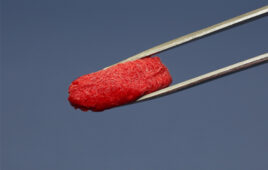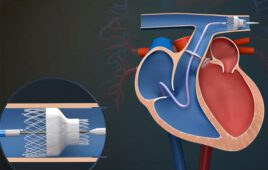Swelling fluids provide an effective, efficient and environmentally better way to join silicone, polyurethane or other thermoelastic tubing to fittings and molded parts.
Jay Tourigny, MicroCare Medical

(Image courtesy of MicroCare)
Today’s cutting-edge medical devices use advanced and sophisticated materials. This includes the tubes used in venous access devices, drainage catheters, dialysis machines and any other tubing that transfers fluids, medications, gases, guide wires or other materials.
Lighter, more flexible tubing makes handling, storing and using the devices easier. Some next-generation devices now use multi-lumen tube construction, with multiple channels running inside a single tube. This simplifies the device by reducing the number of tubes needed. In addition, smaller-diameter, thinner-walled tubes reduce the overall weight of the device, making it more manageable to lift and carry.
However, there is a drawback to these updated tubing designs. Small, complex devices are often more challenging to manufacture — especially assembly in which connecting the thin or soft tubes to rigid plastic barbed fittings can be labor-intensive and slow.
Assembly woes
Many medical device fabricators prefer silicone elastomers as tubing materials. Medical-grade silicone tubing is durable, flexible and versatile. It also resists bacterial growth and is easy to sterilize. But joining complex silicone tubing onto parts made of harder materials can be difficult. First, while silicone is flexible, it generally does not expand or stretch without assistance. Second, silicone has a high coefficient of friction, or a tacky surface, that makes sliding a silicone tube onto a fitting tough.
Many tubing devices assemble by hand. Manually pushing or twisting tubes into place is hard for assemblers, sometimes causing carpal tunnel syndrome, wrist problems and other workplace-related injuries. Also, forcibly pressing small silicone tubing onto a barbed fitting sometimes results in stress-cracked tubes and scrapped materials.
Fortunately, there are fluids to make connecting fittings onto tubes quicker and easier. There are three common fluid types: silicone oil, isopropyl alcohol and swelling fluids:
- Silicone oil makes tube assembly easier, but it is messy. The oil stays on surfaces indefinitely. Plus, the oil tends to migrate throughout the production facility, coating other equipment and surfaces. It captures surrounding dirt in the process, making facility hygiene a constant challenge.
- Ultra-pure isopropyl alcohol (IPA) lubricates silicone tubes fairly well. IPA is readily available and is relatively inexpensive. But IPA dries slowly, which increases assembly cycle time. Also, IPA allows thin-wall tubing with less structural rigidity to collapse or fold over during assembly operations. This makes it harder to press or slide the tubing onto a fitting.
- By temporarily swelling tube ends to increase their size, swelling fluids make fitting tubes onto barbed connectors simple and faster. Two of the most common swelling fluids are hexane and engineered silicone-based swelling fluid.
Hexane as a swelling fluid
Hexane works well for swelling but must be used with care. It is extremely aggressive. It might remove ink markings or surface coatings, damage plastic components or permanently change the physical properties of the tubing. Hexane smells strong, so proper ventilation or personal protective equipment is essential. It is also classified as a hazardous air pollutant (HAP) and may contribute to air-quality issues.
Silicone-based swelling fluid
A better option is engineered silicone swelling fluid. One end of a silicone tube soaks in the swelling fluid, causing the tubing wall to uniformly expand. Soaking time determines how much the tubing swells. For instance, a tube that needs 1%–2% expansion for assembly typically soaks for less than a minute.
The swelling fluid does not change the tubing’s physical properties. After the tube fits onto the connector, the swelling fluid evaporates quickly and completely. The tubing recovers to its original size, color, shape, durometer, compression and strength. It forms a tight, leak-proof, secure grip over the fitting, no matter how complex the geometry. It does not bond or weld the tubing and fitting together, making it easier to separate them later, if required.
Unlike hexane, silicone swelling fluids are an environmentally sustainable choice. They have a low global warming potential (GWP) and comply with most regional air quality regulations. The GWP of a fluid is the amount of greenhouse gas that it emits and gets trapped in the high atmosphere. The trapped gases absorb infrared radiation. The more they absorb over a long period of time, the more they may contribute to global warming. Many manufacturers choose low GWP swelling fluids to help reduce their greenhouse gas output.
Since the swelling fluid’s active ingredient is a methyl siloxane, a member of the silicone family, it doesn’t affect other polymers such as polycarbonate or polyurethane and has excellent compatibility with metal components.
There are other swelling fluids available for many tubing materials, including polyethylene, polyimide, polyurethane and other molded thermoelastomer tubing and hoses.
Simplified process validation
Since silicone swelling fluids don’t require heat, glue or other adhesives that can affect the integrity of the tube, fittings or device, it is easier to qualify and validate in the assembly process. Plus, swelling fluids do not produce residue that could negatively affect cleanroom integrity or the qualification of the manufacturing process.
When choosing a swelling fluid, it is best to consult with a company that specializes in medical lubricating and coating technology. They have the experience and expertise to help choose the best swelling fluid for each individual application.
Jay Tourigny is SVP at MicroCare Medical. With more than 25 years in the medtech industry, he holds numerous U.S. patents for cleaning-related products that are used daily in medical and precision-cleaning applications.
The opinions expressed in this blog post are the author’s only and do not necessarily reflect those of Medical Design and Outsourcing or its employees.




